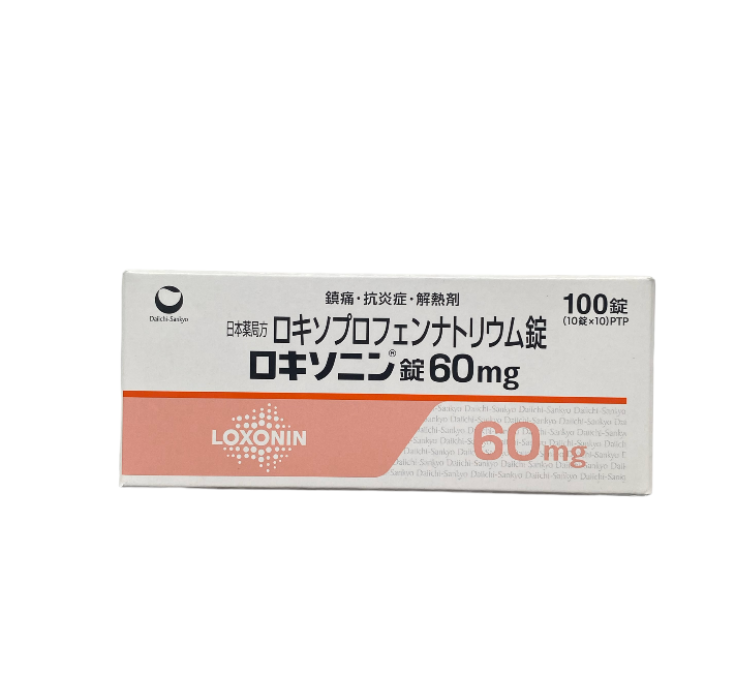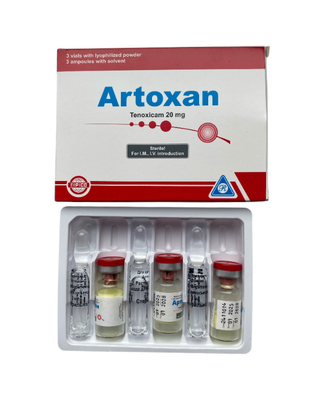Loxonin 60 mg 100 Tab
€38
against pain and inflammation
In stock
Loxonin 60 mg 100 Tab
Product Details
Loxonin 60 mg 100 tab.
Product Information
Description:
This medicine suppresses the formation of prostaglandins, which cause inflammation, and acts to relieve swelling/pain caused by inflammation, as well as to reduce fever.It is commonly used to treat rheumatoid arthritis and osteoarthritis. It is also used to reduce pain and inflammation after surgery, injury and tooth extraction, as well as to reduce fever or relieve pain caused by acute inflammation of the upper respiratory tract.
Dosage:
To reduce inflammation and pain caused by rheumatoid arthritis, osteoarthritis, lumbar pain, frozen shoulder, neck-shoulder-arm syndrome, toothache, as well as after surgery/wounds/tooth extraction: As a rule, adults should take 1 tablet (60 mg of loxoprofen sodium) per day. time, 3 times a day. When taken on demand, take 1 to 2 tablets (60 to 120 mg) at a time.
To reduce fever or pain caused by acute inflammation of the upper respiratory tract: As a rule, adults should take 1 tablet (60 mg of loxoprofen sodium) at a time, as needed. Usually up to twice a day. Do not take more than 3 tablets (180 mg) per day.
The dose can be adjusted depending on your age and symptoms. Avoid taking the medicine on an empty stomach. Follow the instructions strictly.
If you missed an appointment, take the missed dose as soon as possible. If it's almost time to take the next dose, skip the missed dose and continue taking it according to your usual schedule. You should never take two doses at the same time.
If you accidentally take a dose higher than prescribed, consult your doctor or pharmacist.
Do not stop taking this medicine unless your doctor instructs you to do so.
Contraindications:
If you have previously experienced any allergic reactions (itching, rash, etc.) to any medications.
If you have: stomach ulcer, blood, liver/kidney/heart disease, aspirin asthma or a history of its manifestations.
If you are pregnant or breastfeeding.
If you are taking any other medications. (Some medications may interact to enhance or weaken the therapeutic effect. Beware of over-the-counter medications and dietary supplements, as well as other prescription medications.)
Keep out of the reach of children. Keep away from direct sunlight, heat and moisture.
Throw away the leftovers. Don't keep them.
Possible side effects:
The most commonly reported adverse reactions include stomach discomfort, abdominal pain, abdominal pain, nausea/vomiting, loss of appetite, swelling, rash, urticaria, drowsiness, fever and itching. If any of these symptoms occur, consult your doctor or pharmacist.
The symptoms described below are rarely considered as the initial symptoms of the adverse reactions indicated in parentheses. If any of these symptoms occur, stop taking this medicine and consult your doctor immediately.
pallor of the face, difficulty breathing, cold sweat [shock, anaphylaxis]
bleeding from the nose/gums, bruising on the extremities [agranulocytosis, hemolytic anemia, leukopenia, thrombocytopenia]
redness/swelling/rash/blisters on the skin/mucous membranes, fever, general malaise [toxic epidermal necrosis, ocular mucosa syndrome]
decreased diuresis, edema, loss of appetite [acute renal dysfunction, nephrotic syndrome, interstitial nephritis]
shortness of breath, general edema [congestive heart failure]
fever, cough, shortness of breath [interstitial pneumonia]
vomiting of blood, blood in the stool [bleeding from the digestive tract]
abdominal pain, stomach pain [perforation of the digestive tract]
nausea, abdominal pain, feeling of enlargement in the abdomen [narrowing and obstruction of the gastrointestinal tract]
general fatigue, nausea, yellowing of the skin/whites of the eyes [impaired liver function, jaundice]
shortness of breath, wheezing [asthma attack]
fever, headache, nausea [aseptic meningitis]
muscle pain, feeling of weakness [rhabdomyolysis]
The above symptoms do not describe all the adverse reactions to this medicine. Consult your doctor or pharmacist if you notice any alarming symptoms other than those listed above.
Manufacturer: DAIICHI SANKYO Japan
You May Also Like


